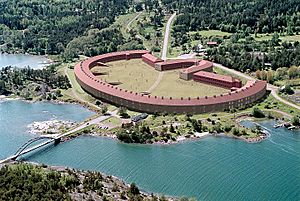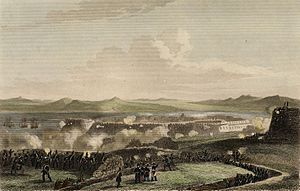Battle of Bomarsund facts for kids
Quick facts for kids Battle of Bomarsund |
|||||||
|---|---|---|---|---|---|---|---|
| Part of the Åland War and the Crimean War | |||||||
 A sketch of the quarter deck of HMS Bulldog in Bomarsund, Edwin T. Dolby |
|||||||
|
|||||||
| Belligerents | |||||||
| Commanders and leaders | |||||||
| Strength | |||||||
| 32,000 25 paddle sloops |
3,000 | ||||||
| Casualties and losses | |||||||
| 85 killed and wounded | 53 killed and wounded 2,000 captured |
||||||
The Battle of Bomarsund happened in August 1854. It was a big fight during the Åland War, which was part of the larger Crimean War. In this battle, forces from the British and French empires attacked a Russian fortress. This battle was the only major event of the war that took place at Bomarsund in the Baltic Sea.
Contents
Why Bomarsund Was Important
Bomarsund was a fortress built by Russia starting in 1832. It was located in Sund, Åland, in the Baltic Sea. The fortress was not fully finished when the war began. Only two of the planned twelve smaller towers were built. This made it weak, especially if attacked from land.
The fortress designers thought large ships couldn't get close because of narrow sea passages. This was true for old sailing ships. But new steam-powered ships could reach parts of the fortress that were not well defended. This new technology changed how battles could be fought at sea.
The First Attack
On June 21, 1854, three British ships started firing at the Bomarsund fortress. The Russian artillery on shore fired back. Both sides had some damage, but not many people were hurt. This first fight didn't have a clear winner.
During this battle, a brave sailor named Charles Davis Lucas became famous. A Russian cannonball landed on his ship. He quickly picked it up and threw it overboard before it exploded. For saving his ship and crew, he was the very first person to receive the Victoria Cross. This is the highest award for bravery in the British military.
The Main Battle Begins
The first attack was just a quick fight. But the second battle was much bigger. By the end of July 1854, a large British fleet of 25 ships had surrounded the fortress. They were waiting for French soldiers to arrive. Both the Russians defending the fort and the attacking British and French knew that ships alone couldn't defeat the fortress.
The Russians tried to make it harder for the attackers by destroying the land around the fort. This was meant to stop the British and French from setting up a long siege.
Troops Land and Artillery Fires
On August 8, about 7,000 French soldiers landed south of Bomarsund. Another 2,000 French soldiers and 900 British marines landed to the north. Two days later, their cannons arrived. The British set up three large 32-pounder guns on a hill. The French also set up several cannon batteries.
On August 13, 1854, the French cannons began firing at one of the fortress's towers, called Brännklint. By the end of the day, the French infantry (foot soldiers) attacked the tower. The Russian defenders realized they couldn't hold the tower. Most of them left, leaving a small group to blow up the tower.
French troops captured the tower before it could be fully destroyed. But then, Russian artillery started firing at their own captured tower. On August 15, 1854, a Russian cannonball hit the tower's gunpowder storage. The huge explosion completely destroyed the tower.
The Fortress Falls
The main attack on the fortress began late on August 15, 1854. Cannons on land and ships at sea all started firing. The second tower, called Notvik, was also destroyed after British cannons fired at it from their hill.
The Russian forces inside the main fortress hoped the British and French would attack by land. But the bombardment continued into August 16 without any sign of a land attack. It became clear that the British and French planned to destroy the fortress with cannon fire. After eight hours of constant firing, they made a huge hole in the fortress walls. Most of the Russian cannons were also destroyed.
On August 16, 1854, the Russian commander of the fortress surrendered to the British and French forces. This surrender happened faster than the attackers expected. About 2,000 Russian soldiers put down their weapons and became prisoners of war.
What Happened Next
After the surrender, the French and British forces completely destroyed the Bomarsund fortress. British engineers stayed until mid-September to make sure it couldn't be easily rebuilt. About 700,000 bricks from the destroyed fortress were taken by boat to Helsinki. These bricks were later used to help build the Uspenski Cathedral.
Three hundred Finnish soldiers, who were part of the Russian forces, were captured. They were taken to Lewes, England, and held as prisoners until the war ended. When the war was over, they were released and sent back to Finland. They returned with a song about their experiences, called the War of Åland (or "Oolannin sota" in Finnish). A memorial was built in Lewes in 1877 to remember those who died as prisoners of war.
In the Treaty of Paris in 1856, the entire Åland Islands area was made a "demilitarized zone." This means no military forces or bases are allowed there, a rule that is still followed today.
The Bomarsund Bridge today connects Bomarsund to Prästö.
Heroes of the Baltic Sea
Besides Charles Davis Lucas, several other brave soldiers received the Victoria Cross for their actions in the Baltic Sea during the Crimean War.
Other Victoria Cross heroes from the Baltic Sea:
- John Bythesea – 1854; Åland Islands
- William Johnstone – 1854; Åland Islands
- George Ingouville – 1855; Fort of Viborg
- George Dare Dowell – 1855; Fort of Viborg
Images for kids






